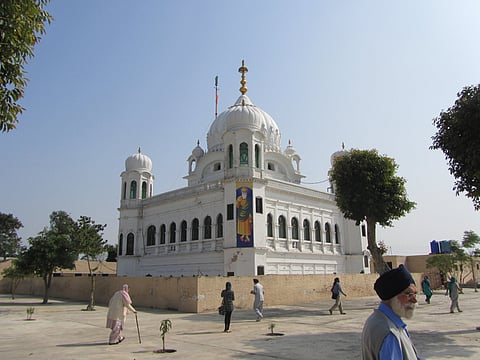Kartarpur Sahib: A shrine too far
Politics behind corridor to bridge two key places of pilgrimage to the Sikh community

Recently, Indian Prime Minister Narendra Modi made this extraordinary claim while campaigning in Rajasthan, ‘My destiny has been to fix Congress’ wrongs…We should ask them, why they let Kartarpur go to Pakistan at the time of Partition’. Is wilful ignorance of history the reason for this grandiloquent and malevolent assertion or are lessons in geography the need of the hour for the prime minister?
The first Guru of Sikhs, Guru Nanak, founded Kartarpur in 1504 CE on the right bank of the Ravi River and established the first Sikh commune there. Following his death in 1539, Hindus and Muslims both claimed him as their own and raised mausoleums in his memory. The changing course of the Ravi River eventually washed away the mausoleums, but the sons of Guru Nanak managed to save the urn containing his ashes and reburied it on the left bank of the river Ravi, where a new habitation was formed, representing the present day Dera Baba Nanak, a town in the district of Gurdaspur, in India. The vagaries of the course of the river, and the horrific events of 1947 then rent asunder two of the most important places of pilgrimage to the Sikh community: Kartarpur Sahib, in Pakistan, and Dera Baba Nanak in India. The much talked about Kartarpur Corridor is an attempt to bridge this forced parting of ways.
To get to Kartarpur, we need to get to Gurdaspur and for that we need to get on the Radcliffe Line. The Indian Express’ The pilgrims’ long route had this to say: ‘Had Gurdaspur district not been awarded to India by the Radcliffe Award, the angst of losing Kartarpur would perhaps have been less since it would have been located deep inside Pakistan’. This narrative gets even more difficult when the epic struggle for owning the princely state of Kashmir gets yoked to it. Yes, the thread linking Kartarpur, Gurdaspur and Kashmir is intricate and complex and the prime minister simply chose to obfuscate for electoral advantage, a trait we have seen in the past.
The boundary demarcation line between the Indian and Pakistani portions of the Punjab and Bengal provinces of British India was named after its architect, Sir Cyril Radcliffe, who was also the joint chairman of the two boundary commissions for the two provinces. The Radcliffe Line has been a contentious one and there has been much speculation that India got the better of Pakistan especially in the division of Punjab. And Gurdaspur looms large in these rumours, some outlandish, but some credible enough to be taken seriously.
The Tribune’s ‘Gurdaspur – the district that almost went to Pakistan’ — says: ‘Till August 17, 1947, it was assumed that the district would be in Pakistan territory’. But a last minute alteration by Sir Cyril Radcliffe of the map of partition changed all that: the highly strategic district remained with India. Why Radcliffe changed his mind has been a mystery and has fed a feverish conspiracy theory to this day. The next why, in this saga is: why is Gurdaspur so important? The best seller Freedom at Midnight says “Without Gurdaspur, India would have no practicable land access to Kashmir.” So there you have the connection to Kashmir. It was because of this decision that India could hold on to Kashmir in October 1947. India sent the Army and equipment by road to Kashmir via Gurdaspur, the only available route to the Valley. The route — National Highway 1 that goes through Pathankot -– continues to be the main connection to the Valley.
Mischievous link
The contentious Gurdaspur district then consisted of four tehsils, Shakargarh and Pathankot to the north, and Gurdaspur and Batala to the south and of the four, only Shakargarh separated from the rest of the district by the River Ravi was awarded to Pakistan. There is credible information to conclude that the Indian leaders involved in drawing up the final borders between the two successor states indirectly influenced Radcliffe to redraw his line to favour India. And it does not require much imagination to guess that none other than the Congress party and Nehru, the country’s first prime minister had a direct hand in this delicate negotiation. Yes, looking back, it is easy to say, if Gurdaspur could be snatched away why not Kartarpur as well? This line of argument shows a poor grasp of the partition story: at best it is naivete or ignorance. Geographical features like the head waters of the canals, natural landmarks like the course of a river (in this case, Ravi) to an some extent were cited as the reasons for awarding Gurdaspur to India but to link Kartarpur to a just and fair division of Punjab is mischievous.
Simply put, Karatarpur was strategically not important enough. Its loss though scarred the Sikhs.
Sign up for the Daily Briefing
Get the latest news and updates straight to your inbox


